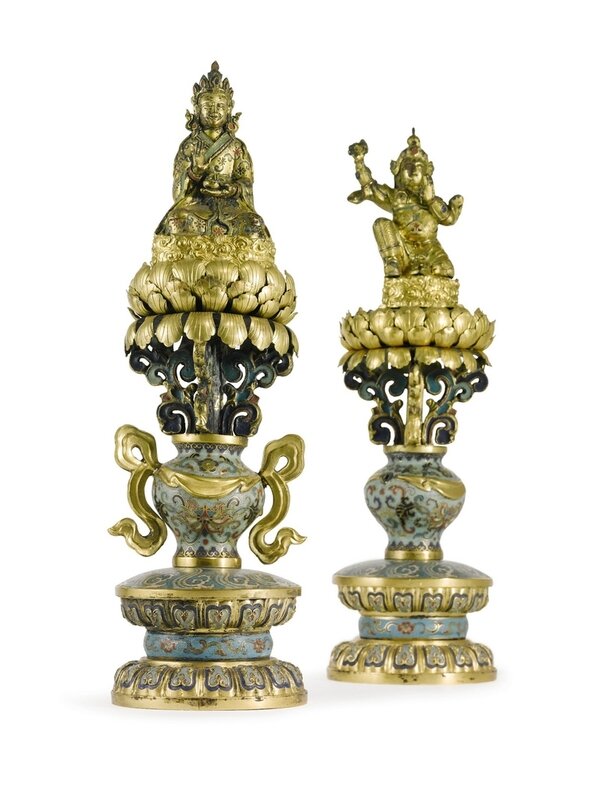Two important and rare Imperial Chinese cloisonné Buddhist altar pieces, Qianlong period (1736-1795)
Lot 496. Two important and rare Imperial Chinese cloisonné Buddhist altar pieces, Qianlong period (1736-1795). Height 15 in. 38 cm. Estimate 70,000-90,000 USD. Lot sold 110,500 USD. Photo Sotheby's 2012
of champlevé- and cloisonné-enamel gilt-bronze, comprising two of the Seven Emblems of Imperial Power, Qizhengbao, one of a minister seated with his right hand in abhayamudra and left hand holding an alms bowl, the other figure of a general, kneeling with right leg raised, right arm raising scroll and left hand in abhayamudra, both set upon a base of swirling clouds, a large lotus flower with enameled seed-pod and elaborate overlapping gilt-bronze petals arrayed in three upright and one pendant register, and scrolling champlevé leaves, all issuing from a beribboned baluster vase set enameled with scrolling waves, wood stands.
Note: The Seven Emblems of Imperial Power, qizhengbao, according to the Buddhist Sutra, are the accessories of the universal monarch, the Chakravartin. They represent the different abilities or aides that a king must possess in order to stay in power and can be symbolically offered to the Buddha. The Seven Emblems include, the Precious Wheel, the Precious Jewel, the Precious Queen, the Precious Minister, the Precious General, the Precious Elephant and the Precious Horse.
Sotheby's. Property from the Estate of Brooke Astor. New York, 24 sept. 2012

/https%3A%2F%2Fprofilepics.canalblog.com%2Fprofilepics%2F1%2F0%2F100183.jpg)
/https%3A%2F%2Fstorage.canalblog.com%2F03%2F02%2F119589%2F96711876_o.jpg)
/https%3A%2F%2Fstorage.canalblog.com%2F11%2F31%2F119589%2F94773502_o.jpg)
/https%3A%2F%2Fstorage.canalblog.com%2F20%2F83%2F119589%2F94772815_o.jpg)
/https%3A%2F%2Fstorage.canalblog.com%2F26%2F72%2F119589%2F75604929_o.jpg)
/https%3A%2F%2Fstorage.canalblog.com%2F59%2F60%2F119589%2F26458628_o.jpg)




/http%3A%2F%2Fstorage.canalblog.com%2F98%2F98%2F119589%2F129097971_o.jpg)
/http%3A%2F%2Fstorage.canalblog.com%2F93%2F75%2F119589%2F128489120_o.jpg)
/http%3A%2F%2Fstorage.canalblog.com%2F09%2F29%2F119589%2F128488304_o.jpg)
/http%3A%2F%2Fstorage.canalblog.com%2F62%2F18%2F119589%2F128488091_o.jpg)